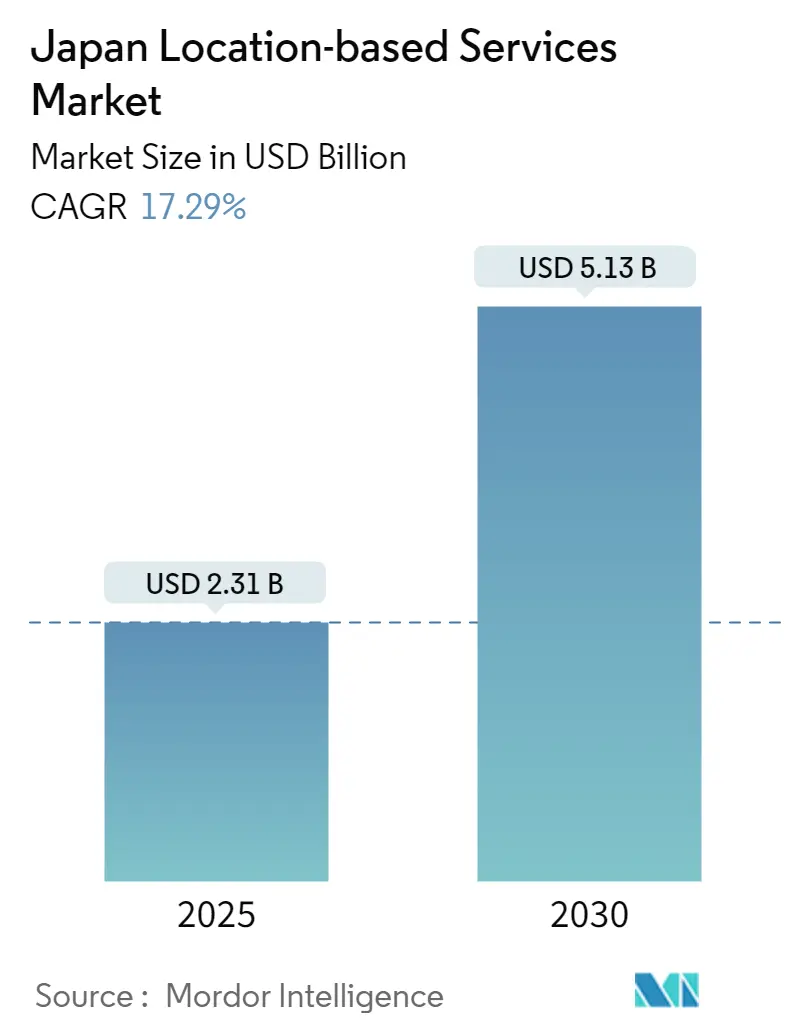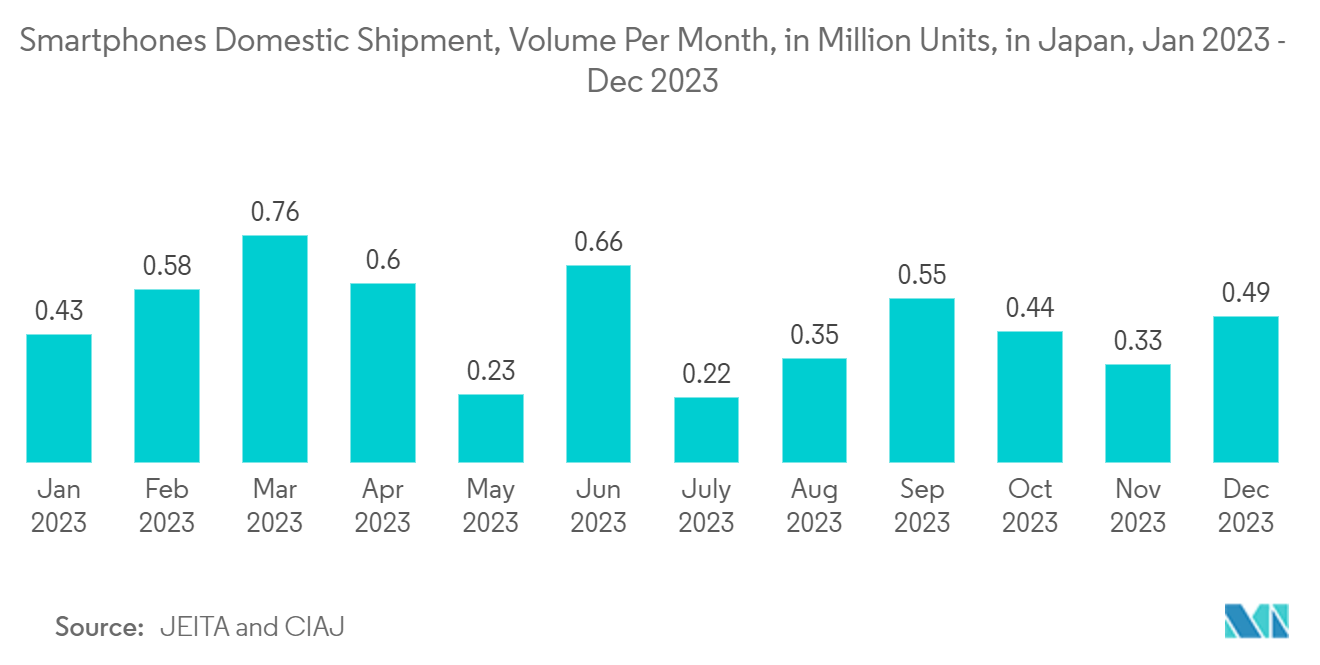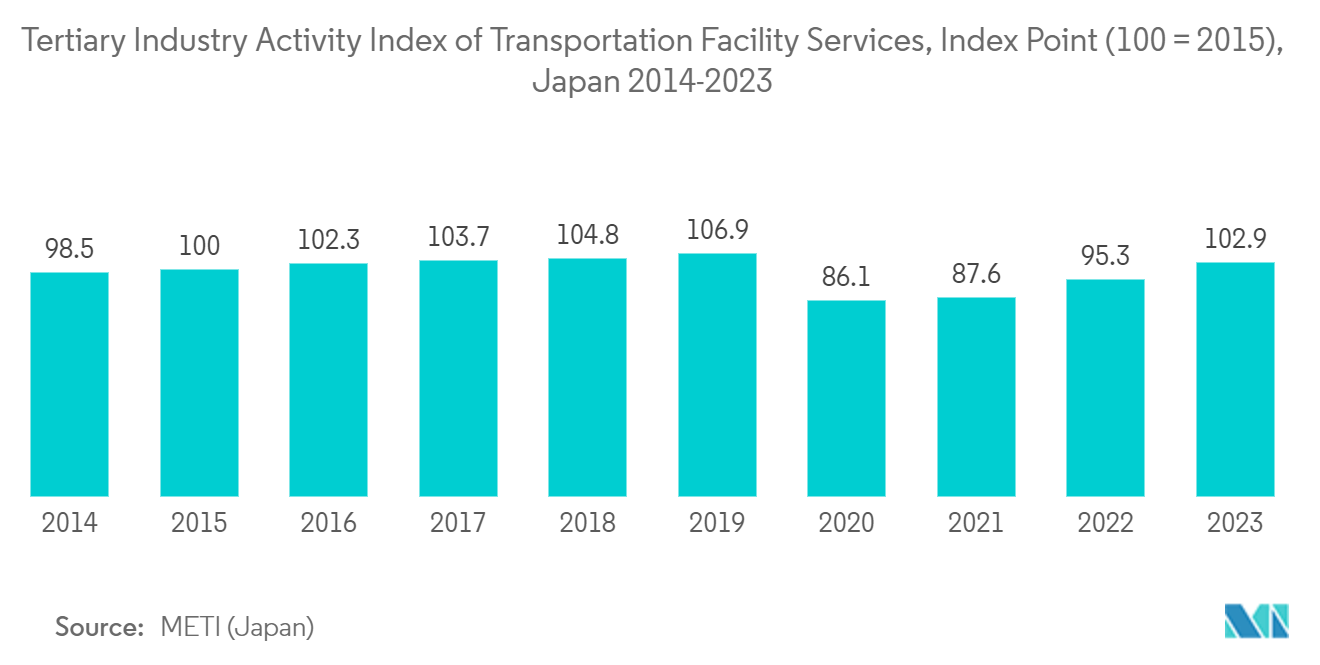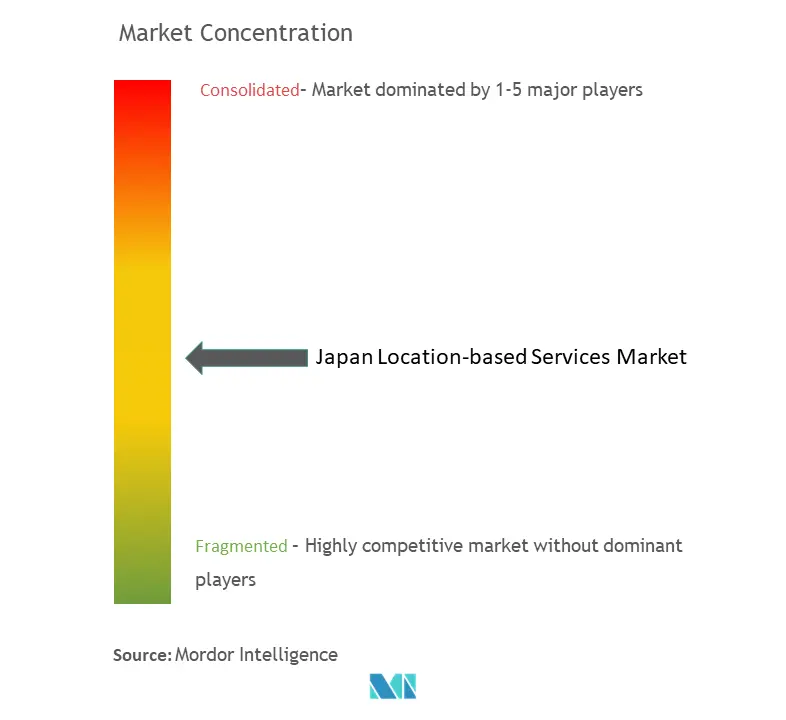Japan Location-based Services Market Size and Share

Japan Location-based Services Market Analysis by Mordor Intelligence
The Japan Location-based Services Market size is estimated at USD 2.31 billion in 2025, and is expected to reach USD 5.13 billion by 2030, at a CAGR of 17.29% during the forecast period (2025-2030).
The surge in the overall demand for enterprise and personal navigation services is one of the major factors driving the Japan Location-based Services Market's growth significantly.
- The Japan Location-based Services Market is mainly driven by the increasing deployment of efficient car navigation systems, especially for seamless location-based services. According to the Japan Electronics and Information Technology Industries Association, around 4.4 million car navigation systems were shipped to Japan in 2022. A rise in such shipments will significantly augment the market's growth opportunity.
- Furthermore, Japan has seen a rising trend in terms of using social networking apps and sites. Social media services are a gradually influential means of communication in Japan. People mostly use their smartphones to access social networks, check locational reviews, tag locations, find friends, check in, etc. All these services utilize LBS through the user's smartphone's in-built GPS feature. Hence, a rise in the overall usage of such applications will enhance the market's growth to a great extent.
- On the other hand, Japan is a popular tourist destination and attracts millions of tourists yearly. The location-based services play a significant role in. assisting and guiding tourists in terms of exploring the country. These services offer directions, maps, and information about nearby restaurants, attractions, accommodations, etc., boosting the overall travel experience. According to the Ministry of Economy, Trade and Industry (Japan), in 2022, the total industry activity index for passenger transportation in Japan stood at around 81.4 points, rising from 72 points in the prior year. Such a rise in the overall industry activity index for passenger transportation in Japan will drive the demand for the market's growth exponentially.
- However, factors like a rise in privacy, as well as security-related concerns, might be significant points that can hinder the overall market's growth throughout the forecast period.
- The players in the market are investing in their services to expand their market share. For instance, SoftBank is Japan’s one of the largest mobile carriers. It has roughly 44 million subscribers with an ARPU of about USD41. SoftBank launched the 5G service in 2020 in limited areas of Japan. By 2025, the company plans to invest over USD 1.9 billion to expand its network to roughly 64% of the populated regions of the country. It plans to install 7,355 base stations in the 3.7GHz and 4.5GHz spectrum bands and 3,855 base stations in the 28GHz band.
Japan Location-based Services Market Trends and Insights
The Increasing Adoption of Mobile Devices
- In recent times, Japan has witnessed a significant rise in the overall usage of mobile phones. It is primarily due to its affordability, integrated with various advanced technologies. This surge in the usage of mobile phones, especially smartphones, has a vital impact on the adoption of location-based services within the country.
- Also, popular navigation apps like Google Maps in Japan provide real-time traffic information, accurate turn-by-turn directions, and alternative routes to assist drivers in navigating efficiently. Smartphones enable drivers to search for nearby points of interest, such as restaurants, gas solutions, hotels, and other attractions. These apps provide detailed information about these places, including user ratings, reviews, directions, and contact details.
- Location-based services on smartphones deliver real-time traffic updates as well as information on road conditions in Japan. This helps the drivers plan their routes and avoid road closers or congested areas, especially during park travel times or in case of road maintenance. Moreover, finding parking in busy cities like Tokyo can be difficult. However, several smartphone apps specifically designed for parking services in Japan help and assist drivers in locating available parking spaces, provide information about fare rates and even enable digital payment.
- As per the Ministry of Internal Affairs and Communications (Japan), as of March 2022, NTT Docomo, Inc. held the largest market share in terms of mobile phone subscriptions in Japan, which totaled around 41.7 percent when added with the subscriptions recorded by the mobile virtual network operators (MVNOs). The KDDI Group positioned second with an overall market share of around 30.5 percent.
- As per the JEITA, in December 2023, Japan saw a monthly domestic shipment volume of approximately 490,000 smartphones, constituting 73.4% of the total mobile phone shipments.

Transportation and Logistics Sector Expected to Witness Significant Growth
- The transportation and logistics sectors are vital in augmenting location-based services in Japan. Transportation and logistics companies accumulate massive amounts of geospatial data through their shipping routes, fleet of vehicles, and delivery networks. This data involves traffic patterns, GPS coordinates, transportation hubs, and delivery points. This data forms the basis for location-based services.
- The transportation and logistics sector provides reliable location data, essential for location-based service applications. This data enables return tracking, precise mapping, and face routing of goods and services. Moreover, location-based service providers can help transportation logistics companies optimize their supply chain distribution network and warehouse locations. This optimization improves operational efficiency, reduces costs, and better overall logistic performance.
- As per e-Stat (Japan), In 2022, the private sector entities in Japan signed construction contracts for warehouses and distribution facilities amounting to around 1.94 trillion Japanese yen. In contrast, it was around 1.55 trillion Japanese yen in the previous year. Such a rise in the total count of contracts is expected to drive the market's growth exponentially during the forecast period.
- The transmission industry employs monitoring and tracking systems to manage shipments and fleets effectively. This system uses GPS and other location-based technologies to deliver real-time information about vehicle and cargo's location conditions and status. Also, the Location-based service providers can tap into this real-time data to provide live tracking services to consumers allowing them to track the overall movement of their transportation or shipment options.
- According to the Ministry of Internal Affairs and Communications (Japan), in 2022, Japan's road freight transport industry employed around 2.01 million people on average. The transportation industry's second-strongest workforce was noted in the road passenger transport segment, further highlighting the significance of road transport for the Japanese economy.
- According to METI (Japan), in 2023, Japan's transportation facilities services industry activity index rose to 102.9 points, up from 95.3 points in the preceding year. The Tertiary Industry Activity Indices track business trends in Japan's service sectors. The Indices of Tertiary Industry Activity aim to reveal the trends of business in service industries in Japan.

Competitive Landscape
The ongoing various technological enhancements are expected to be significant trends within the market industry. The businesses and companies operating within the market are thus adopting several strategies to extend their overall customer base and augment their presence throughout the sector. The key strategies include long-term partnerships, acquisitions, and mergers. Some of them are like :
In June 2022, MetCom and NextNav declared a strategic agreement for the countrywide deployment of 3D geolocation services throughout Japan by starting with the Pinnacle vertical location service rollout. The Pinnacle service would first be deployed in the densely populated Osaka and Tokyo metropolitan areas, with the idea to extend coverage to major cities throughout Japan in 2023. Pinnacle would enhance the experience of geolocation services from two dimensions to involve a vertical third dimension and serve unmet requirements in both commercial and public sectors.
In May 2023, Hexagon's Autonomy & Positioning division and Hitachi Zosen Corporation signed an agreement to bring the TerraStar-X Enterprise correction service to Japan. Nippon GPS Data Service (NGDS), a subsidiary of Hitachi Zosen, would provide Hexagon with GNSS data from this network. With this data, Hexagon can thus provide exceptional levels of accuracy and redundancy through the TerraStar-X Enterprise GNSS correction service, which is significant for various automotive applications.
Japan Location-based Services Industry Leaders
-
Google LLC
-
Kokusai Kogyo Co., Ltd.
-
Hitachi, Ltd
-
Waveon Co., Ltd.
-
AGOOP Corp.
- *Disclaimer: Major Players sorted in no particular order

Recent Industry Developments
- March 2023: Mapxus, the indoor Geographic Information System (GIS) platform that offers global indoor mapping and navigation services, has declared the successful kickstart of its Series B funding round, raising more than a total sum of USD 5 million in investment. The funding round was primarily led by Kawasaki Heavy Industries, a Japanese corporation with a varied business portfolio spanning various sectors and industries centered around technology.
- January 2023: The Space Force has delivered the first of its two planned space surveillance payloads, especially for the integration with Japan's Quasi-Zenith Satellite System (QZSS), with the release planned for later this year on Tokyo's sixth QZSS. The two hosted payloads, built by the Massachusetts Institute of Technology Lincoln Laboratory, would keep tabs on spacecraft in the geosynchronous orbit. The QZSS constellation is primarily built to enhance and complement GPS signals over Japan used for timing, positioning, and navigation.
Japan Location-based Services Market Report Scope
Location-based services (LBSs) are primarily mobile applications that deliver information based on the location of the device and the user through various mobile portable devices, like smartphones or mobile networks. The precision of the location services mainly depends on the software and hardware used in the mobile communication system.
The Japanese Location-based services market is segmented by component (hardware, software, services), by location (indoor, outdoor), by application (mapping and navigation, business intelligence and analytics, location-based advertising, social networking, and entertainment), by end-user (transportation and logistics, IT and telecom, healthcare, government, BFSI, hospitality, manufacturing). The market sizes and forecasts are provided in terms of value in USD for all the above segments.
| Hardware |
| Software |
| Services |
| Indoor |
| Outdoor |
| Mapping and Navigation |
| Business Intelligence and Analytics |
| Location-based Advertising |
| Social Networking and Entertainment |
| Other Applications |
| Transportation and Logistics |
| IT and Telecom |
| Healthcare |
| Government |
| BFSI |
| Hospitality |
| Manufacturing |
| Other End-Users |
| By Component | Hardware |
| Software | |
| Services | |
| By Location | Indoor |
| Outdoor | |
| By Application | Mapping and Navigation |
| Business Intelligence and Analytics | |
| Location-based Advertising | |
| Social Networking and Entertainment | |
| Other Applications | |
| By End-User | Transportation and Logistics |
| IT and Telecom | |
| Healthcare | |
| Government | |
| BFSI | |
| Hospitality | |
| Manufacturing | |
| Other End-Users |
Key Questions Answered in the Report
How big is the Japan Location-based Services Market?
The Japan Location-based Services Market size is expected to reach USD 2.31 billion in 2025 and grow at a CAGR of 17.29% to reach USD 5.13 billion by 2030.
What is the current Japan Location-based Services Market size?
In 2025, the Japan Location-based Services Market size is expected to reach USD 2.31 billion.
Who are the key players in Japan Location-based Services Market?
Google LLC, Kokusai Kogyo Co., Ltd., Hitachi, Ltd, Waveon Co., Ltd. and AGOOP Corp. are the major companies operating in the Japan Location-based Services Market.
What years does this Japan Location-based Services Market cover, and what was the market size in 2024?
In 2024, the Japan Location-based Services Market size was estimated at USD 1.91 billion. The report covers the Japan Location-based Services Market historical market size for years: 2019, 2020, 2021, 2022, 2023 and 2024. The report also forecasts the Japan Location-based Services Market size for years: 2025, 2026, 2027, 2028, 2029 and 2030.
Page last updated on:
Japan Location-based Services Market Report
Statistics for the 2025 Japan Location-based Services market share, size and revenue growth rate, created by Mordor Intelligence™ Industry Reports. Japan Location-based Services analysis includes a market forecast outlook for 2025 to 2030 and historical overview. Get a sample of this industry analysis as a free report PDF download.



